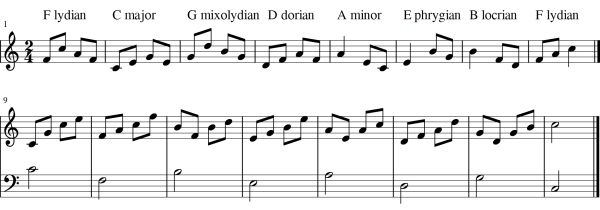Audio: relative key (0:16)

| DIATONIC CIRCLE OF FIFTHS |
|---|
| F C G D A E B |
relative key plays two melodies, the relative key figure shows the score and the table shows the notes in a diatonic circle of fifths.
The first melody is played on a melodica, a cousin of the harmonica. It modulates to relative keys by proceeding clockwise up a fifth through the diatonic circle of fifths:
The second melody is played on a harpsichord in the key of C:
A relative key shares all its notes in common with another key. You cannot get more related than this.
The seven notes in a diatonic circle of fifths are shared by seven related keys.
The diatonic circle of fifths is a subset of the full circle of fifths. It consists of seven consecutive fifths taken from the full circle of fifths. The diatonic circle of fifths in the relative key table contains the notes FCGDAEB. Rearranging these notes in alphabetical order results in ABCDEFG, the key of A natural minor. Starting on another note produces another related key, for example, CDEFGAB is the key of C major. Every key has six related keys.
The diatonic circle of fifths is a modified version of the full circle of fifths because it contains one fifth that is a diminished fifth, a tritone. For example, the end notes, F and B, in the sequence FCGDAEB form an interval of a tritone.
Relative key modulation is modal modulation. The seven related modes are all relative keys. They all share the same notes and they all have the same key signature.
Relative key modulation, or modal modulation, is a subtle feature of writing music. It cannot be signalled by a change in key signature, only by a change to the tonic of the new mode. The first melody in the relative key example demonstrates relative key modulation through the seven modes shown in the score. Modulation only lasts for a single bar, and this type of short-term modulation is called tonicisation.
Relative key modulation can also be interpreted as melodic motion within a single key. This is because in practice it is impossible to distinguish between relative key modulation and normal melodic motion within a single key. This is shown in the second melody in relative key. The score is deliberately unannotated. The melody can be interpreted as relative key modulation starting in C major and proceeding through the modes F lydian, B locrian, E phrygian, A minor, D dorian, G mixolydian and back to C major. Or the melody can be interpreted as melodic motion within the single key of C major.
A common form of relative key modulation is between a major key and its relative minor key. The tonic of a major scale is always the third note of its relative minor scale. Conversely, the tonic note of a minor scale is always the sixth note of its relative major scale. For example, the relative minor of C major is A minor.